Firewalls, Network Security, and Data Protection: A Literature Review
VerifiedAdded on 2023/02/01
|12
|3072
|26
Literature Review
AI Summary
This literature review explores the critical role of firewalls in protecting organizational data and network security. It begins by emphasizing the importance of data security and the implementation of firewalls in IT infrastructure. The review covers hardware and software firewalls, different firewall architectures like packet-filtering, stateful inspection, circuit-level gateways, and proxy firewalls. The paper also discusses the best firewall architecture for an organization based on its specific needs, resources, and compliance requirements. Finally, the review highlights the importance of firewalls in network security, emphasizing their role in protecting business assets, ensuring secure information access, complying with regulatory requirements, and fostering a secure working environment. The review utilizes scholarly articles published within the last ten years to support its findings.

Literature review on Firewalls
Name
Institution
Professor
Course
Date
Name
Institution
Professor
Course
Date
Paraphrase This Document
Need a fresh take? Get an instant paraphrase of this document with our AI Paraphraser

Abstract
Security of the organizational data should be given the highest priority because it is one of the
most valuable assets. The security of the data is dependent on infrastructure design and
protection methodology implemented by the specific organization. Implementation of the
firewall in the organizational IT infrastructure serves to protect unauthorized access of data. A
firewall analyzes and filters all incoming and outgoing signals to ascertain whether they are
authentic. The nature of the firewall should be validated to make sure it can filter data packets as
well as check the content of the packet to prevent malware infection. Firewalls can either be
hardware or software depending on the decision made by organizational management. There are
different types of firewalls such as packet filtering, circuit-level gateway, stateful inspection, and
proxy firewalls. These firewall architecture can secure corporate network with all security
standards. The main goal of all these types of firewalls is to offer secure network and data
protection in an organization.
Security of the organizational data should be given the highest priority because it is one of the
most valuable assets. The security of the data is dependent on infrastructure design and
protection methodology implemented by the specific organization. Implementation of the
firewall in the organizational IT infrastructure serves to protect unauthorized access of data. A
firewall analyzes and filters all incoming and outgoing signals to ascertain whether they are
authentic. The nature of the firewall should be validated to make sure it can filter data packets as
well as check the content of the packet to prevent malware infection. Firewalls can either be
hardware or software depending on the decision made by organizational management. There are
different types of firewalls such as packet filtering, circuit-level gateway, stateful inspection, and
proxy firewalls. These firewall architecture can secure corporate network with all security
standards. The main goal of all these types of firewalls is to offer secure network and data
protection in an organization.
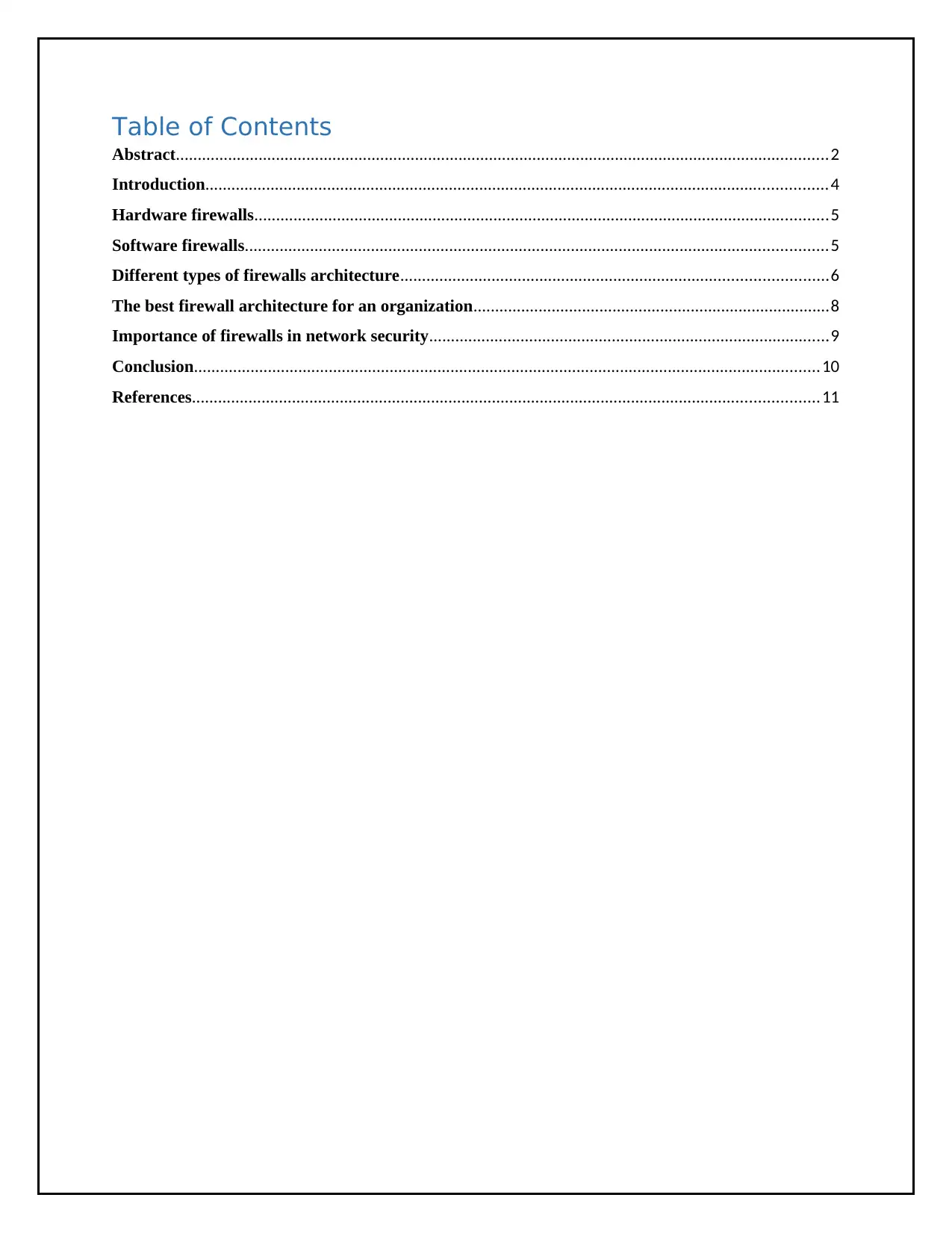
Table of Contents
Abstract......................................................................................................................................................2
Introduction...............................................................................................................................................4
Hardware firewalls....................................................................................................................................5
Software firewalls......................................................................................................................................5
Different types of firewalls architecture..................................................................................................6
The best firewall architecture for an organization..................................................................................8
Importance of firewalls in network security............................................................................................9
Conclusion................................................................................................................................................10
References................................................................................................................................................11
Abstract......................................................................................................................................................2
Introduction...............................................................................................................................................4
Hardware firewalls....................................................................................................................................5
Software firewalls......................................................................................................................................5
Different types of firewalls architecture..................................................................................................6
The best firewall architecture for an organization..................................................................................8
Importance of firewalls in network security............................................................................................9
Conclusion................................................................................................................................................10
References................................................................................................................................................11
⊘ This is a preview!⊘
Do you want full access?
Subscribe today to unlock all pages.

Trusted by 1+ million students worldwide
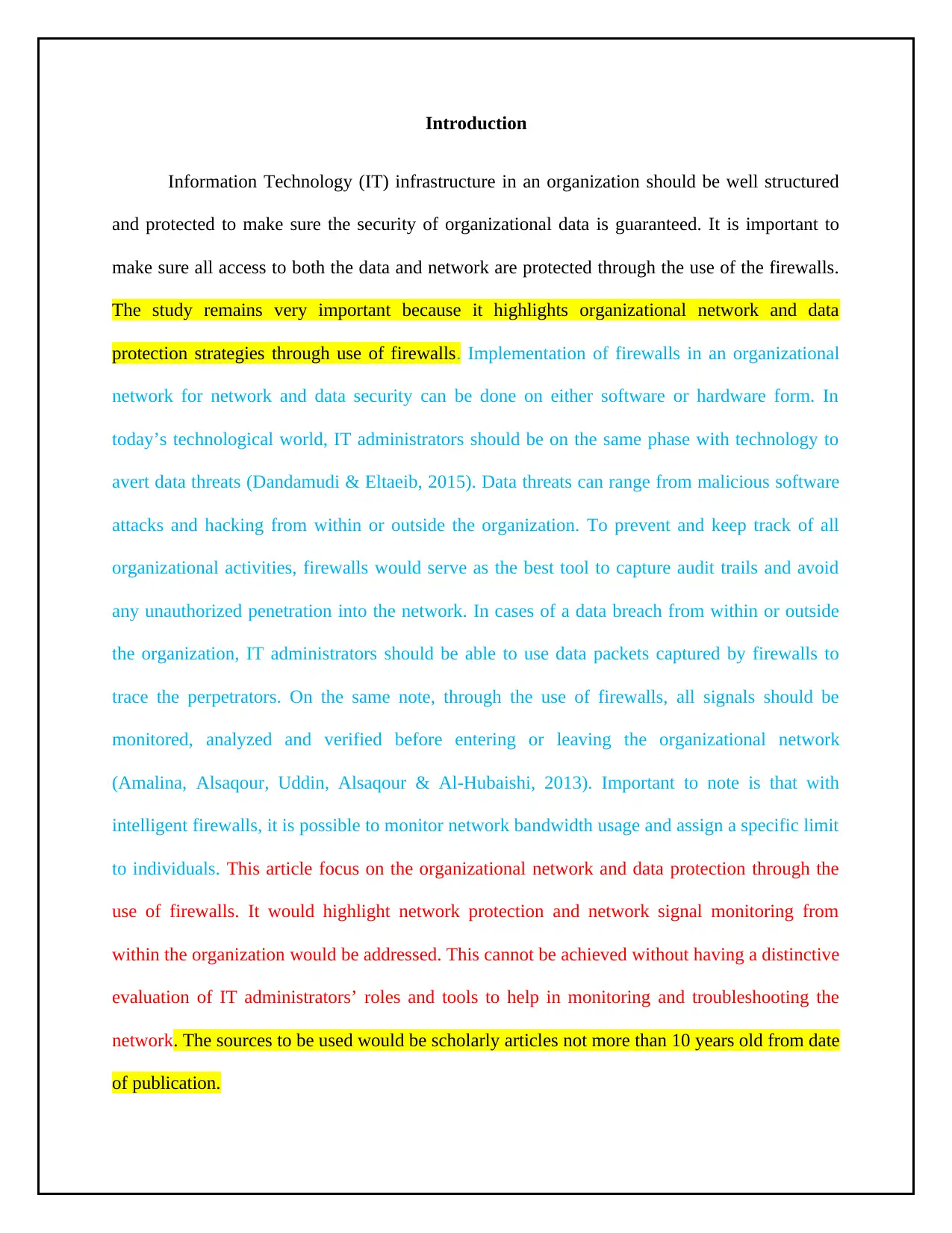
Introduction
Information Technology (IT) infrastructure in an organization should be well structured
and protected to make sure the security of organizational data is guaranteed. It is important to
make sure all access to both the data and network are protected through the use of the firewalls.
The study remains very important because it highlights organizational network and data
protection strategies through use of firewalls. Implementation of firewalls in an organizational
network for network and data security can be done on either software or hardware form. In
today’s technological world, IT administrators should be on the same phase with technology to
avert data threats (Dandamudi & Eltaeib, 2015). Data threats can range from malicious software
attacks and hacking from within or outside the organization. To prevent and keep track of all
organizational activities, firewalls would serve as the best tool to capture audit trails and avoid
any unauthorized penetration into the network. In cases of a data breach from within or outside
the organization, IT administrators should be able to use data packets captured by firewalls to
trace the perpetrators. On the same note, through the use of firewalls, all signals should be
monitored, analyzed and verified before entering or leaving the organizational network
(Amalina, Alsaqour, Uddin, Alsaqour & Al-Hubaishi, 2013). Important to note is that with
intelligent firewalls, it is possible to monitor network bandwidth usage and assign a specific limit
to individuals. This article focus on the organizational network and data protection through the
use of firewalls. It would highlight network protection and network signal monitoring from
within the organization would be addressed. This cannot be achieved without having a distinctive
evaluation of IT administrators’ roles and tools to help in monitoring and troubleshooting the
network. The sources to be used would be scholarly articles not more than 10 years old from date
of publication.
Information Technology (IT) infrastructure in an organization should be well structured
and protected to make sure the security of organizational data is guaranteed. It is important to
make sure all access to both the data and network are protected through the use of the firewalls.
The study remains very important because it highlights organizational network and data
protection strategies through use of firewalls. Implementation of firewalls in an organizational
network for network and data security can be done on either software or hardware form. In
today’s technological world, IT administrators should be on the same phase with technology to
avert data threats (Dandamudi & Eltaeib, 2015). Data threats can range from malicious software
attacks and hacking from within or outside the organization. To prevent and keep track of all
organizational activities, firewalls would serve as the best tool to capture audit trails and avoid
any unauthorized penetration into the network. In cases of a data breach from within or outside
the organization, IT administrators should be able to use data packets captured by firewalls to
trace the perpetrators. On the same note, through the use of firewalls, all signals should be
monitored, analyzed and verified before entering or leaving the organizational network
(Amalina, Alsaqour, Uddin, Alsaqour & Al-Hubaishi, 2013). Important to note is that with
intelligent firewalls, it is possible to monitor network bandwidth usage and assign a specific limit
to individuals. This article focus on the organizational network and data protection through the
use of firewalls. It would highlight network protection and network signal monitoring from
within the organization would be addressed. This cannot be achieved without having a distinctive
evaluation of IT administrators’ roles and tools to help in monitoring and troubleshooting the
network. The sources to be used would be scholarly articles not more than 10 years old from date
of publication.
Paraphrase This Document
Need a fresh take? Get an instant paraphrase of this document with our AI Paraphraser
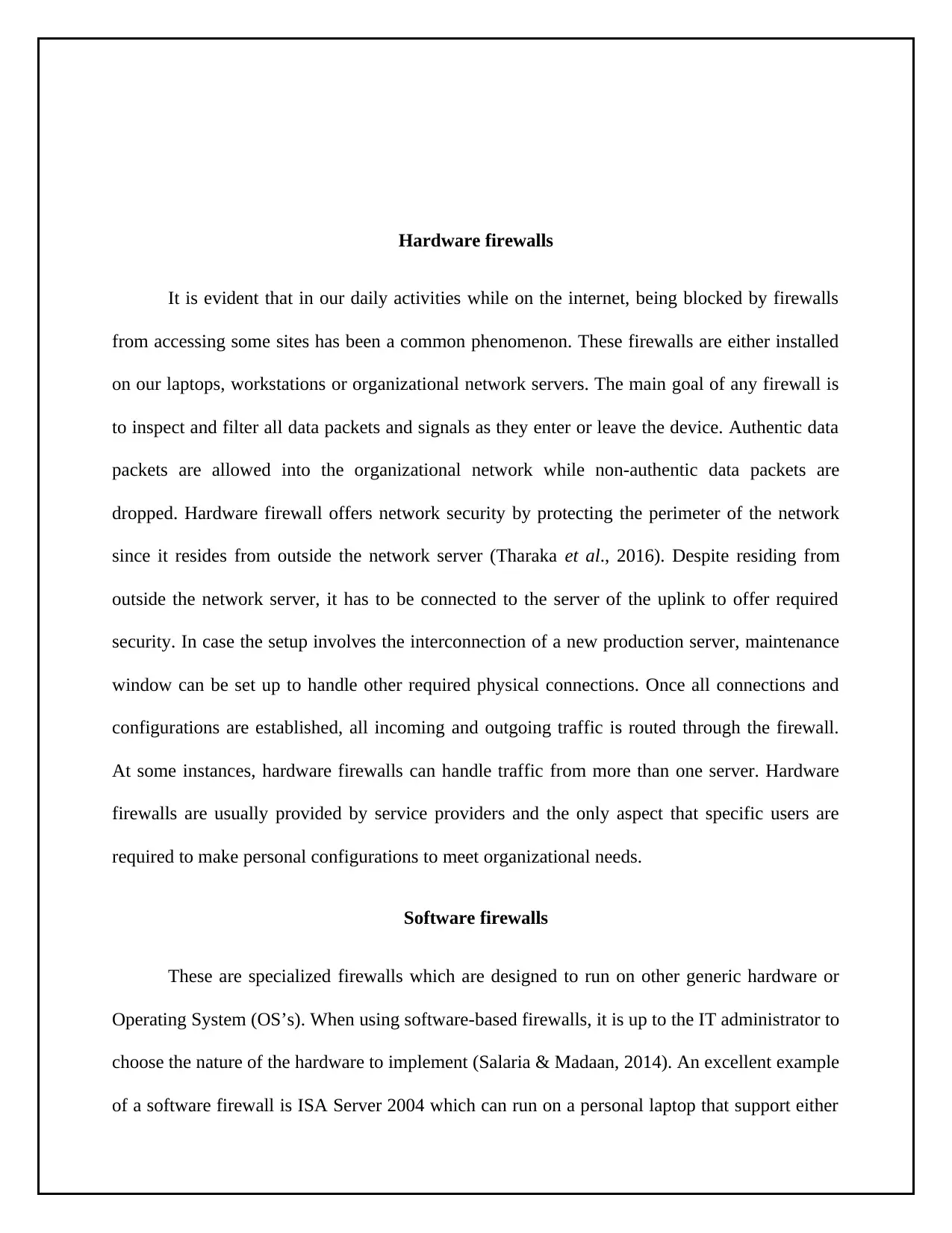
Hardware firewalls
It is evident that in our daily activities while on the internet, being blocked by firewalls
from accessing some sites has been a common phenomenon. These firewalls are either installed
on our laptops, workstations or organizational network servers. The main goal of any firewall is
to inspect and filter all data packets and signals as they enter or leave the device. Authentic data
packets are allowed into the organizational network while non-authentic data packets are
dropped. Hardware firewall offers network security by protecting the perimeter of the network
since it resides from outside the network server (Tharaka et al., 2016). Despite residing from
outside the network server, it has to be connected to the server of the uplink to offer required
security. In case the setup involves the interconnection of a new production server, maintenance
window can be set up to handle other required physical connections. Once all connections and
configurations are established, all incoming and outgoing traffic is routed through the firewall.
At some instances, hardware firewalls can handle traffic from more than one server. Hardware
firewalls are usually provided by service providers and the only aspect that specific users are
required to make personal configurations to meet organizational needs.
Software firewalls
These are specialized firewalls which are designed to run on other generic hardware or
Operating System (OS’s). When using software-based firewalls, it is up to the IT administrator to
choose the nature of the hardware to implement (Salaria & Madaan, 2014). An excellent example
of a software firewall is ISA Server 2004 which can run on a personal laptop that support either
It is evident that in our daily activities while on the internet, being blocked by firewalls
from accessing some sites has been a common phenomenon. These firewalls are either installed
on our laptops, workstations or organizational network servers. The main goal of any firewall is
to inspect and filter all data packets and signals as they enter or leave the device. Authentic data
packets are allowed into the organizational network while non-authentic data packets are
dropped. Hardware firewall offers network security by protecting the perimeter of the network
since it resides from outside the network server (Tharaka et al., 2016). Despite residing from
outside the network server, it has to be connected to the server of the uplink to offer required
security. In case the setup involves the interconnection of a new production server, maintenance
window can be set up to handle other required physical connections. Once all connections and
configurations are established, all incoming and outgoing traffic is routed through the firewall.
At some instances, hardware firewalls can handle traffic from more than one server. Hardware
firewalls are usually provided by service providers and the only aspect that specific users are
required to make personal configurations to meet organizational needs.
Software firewalls
These are specialized firewalls which are designed to run on other generic hardware or
Operating System (OS’s). When using software-based firewalls, it is up to the IT administrator to
choose the nature of the hardware to implement (Salaria & Madaan, 2014). An excellent example
of a software firewall is ISA Server 2004 which can run on a personal laptop that support either
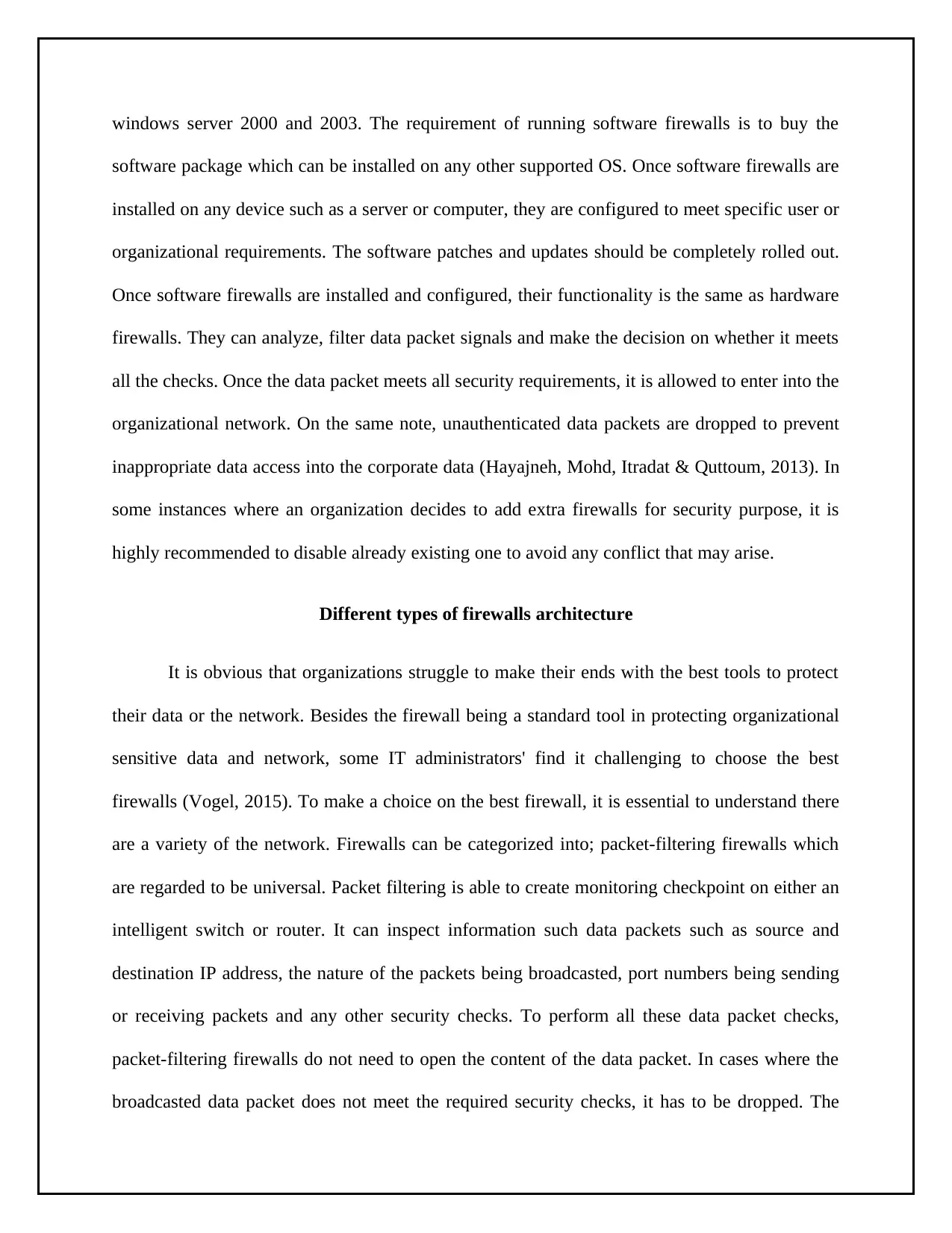
windows server 2000 and 2003. The requirement of running software firewalls is to buy the
software package which can be installed on any other supported OS. Once software firewalls are
installed on any device such as a server or computer, they are configured to meet specific user or
organizational requirements. The software patches and updates should be completely rolled out.
Once software firewalls are installed and configured, their functionality is the same as hardware
firewalls. They can analyze, filter data packet signals and make the decision on whether it meets
all the checks. Once the data packet meets all security requirements, it is allowed to enter into the
organizational network. On the same note, unauthenticated data packets are dropped to prevent
inappropriate data access into the corporate data (Hayajneh, Mohd, Itradat & Quttoum, 2013). In
some instances where an organization decides to add extra firewalls for security purpose, it is
highly recommended to disable already existing one to avoid any conflict that may arise.
Different types of firewalls architecture
It is obvious that organizations struggle to make their ends with the best tools to protect
their data or the network. Besides the firewall being a standard tool in protecting organizational
sensitive data and network, some IT administrators' find it challenging to choose the best
firewalls (Vogel, 2015). To make a choice on the best firewall, it is essential to understand there
are a variety of the network. Firewalls can be categorized into; packet-filtering firewalls which
are regarded to be universal. Packet filtering is able to create monitoring checkpoint on either an
intelligent switch or router. It can inspect information such data packets such as source and
destination IP address, the nature of the packets being broadcasted, port numbers being sending
or receiving packets and any other security checks. To perform all these data packet checks,
packet-filtering firewalls do not need to open the content of the data packet. In cases where the
broadcasted data packet does not meet the required security checks, it has to be dropped. The
software package which can be installed on any other supported OS. Once software firewalls are
installed on any device such as a server or computer, they are configured to meet specific user or
organizational requirements. The software patches and updates should be completely rolled out.
Once software firewalls are installed and configured, their functionality is the same as hardware
firewalls. They can analyze, filter data packet signals and make the decision on whether it meets
all the checks. Once the data packet meets all security requirements, it is allowed to enter into the
organizational network. On the same note, unauthenticated data packets are dropped to prevent
inappropriate data access into the corporate data (Hayajneh, Mohd, Itradat & Quttoum, 2013). In
some instances where an organization decides to add extra firewalls for security purpose, it is
highly recommended to disable already existing one to avoid any conflict that may arise.
Different types of firewalls architecture
It is obvious that organizations struggle to make their ends with the best tools to protect
their data or the network. Besides the firewall being a standard tool in protecting organizational
sensitive data and network, some IT administrators' find it challenging to choose the best
firewalls (Vogel, 2015). To make a choice on the best firewall, it is essential to understand there
are a variety of the network. Firewalls can be categorized into; packet-filtering firewalls which
are regarded to be universal. Packet filtering is able to create monitoring checkpoint on either an
intelligent switch or router. It can inspect information such data packets such as source and
destination IP address, the nature of the packets being broadcasted, port numbers being sending
or receiving packets and any other security checks. To perform all these data packet checks,
packet-filtering firewalls do not need to open the content of the data packet. In cases where the
broadcasted data packet does not meet the required security checks, it has to be dropped. The
⊘ This is a preview!⊘
Do you want full access?
Subscribe today to unlock all pages.

Trusted by 1+ million students worldwide
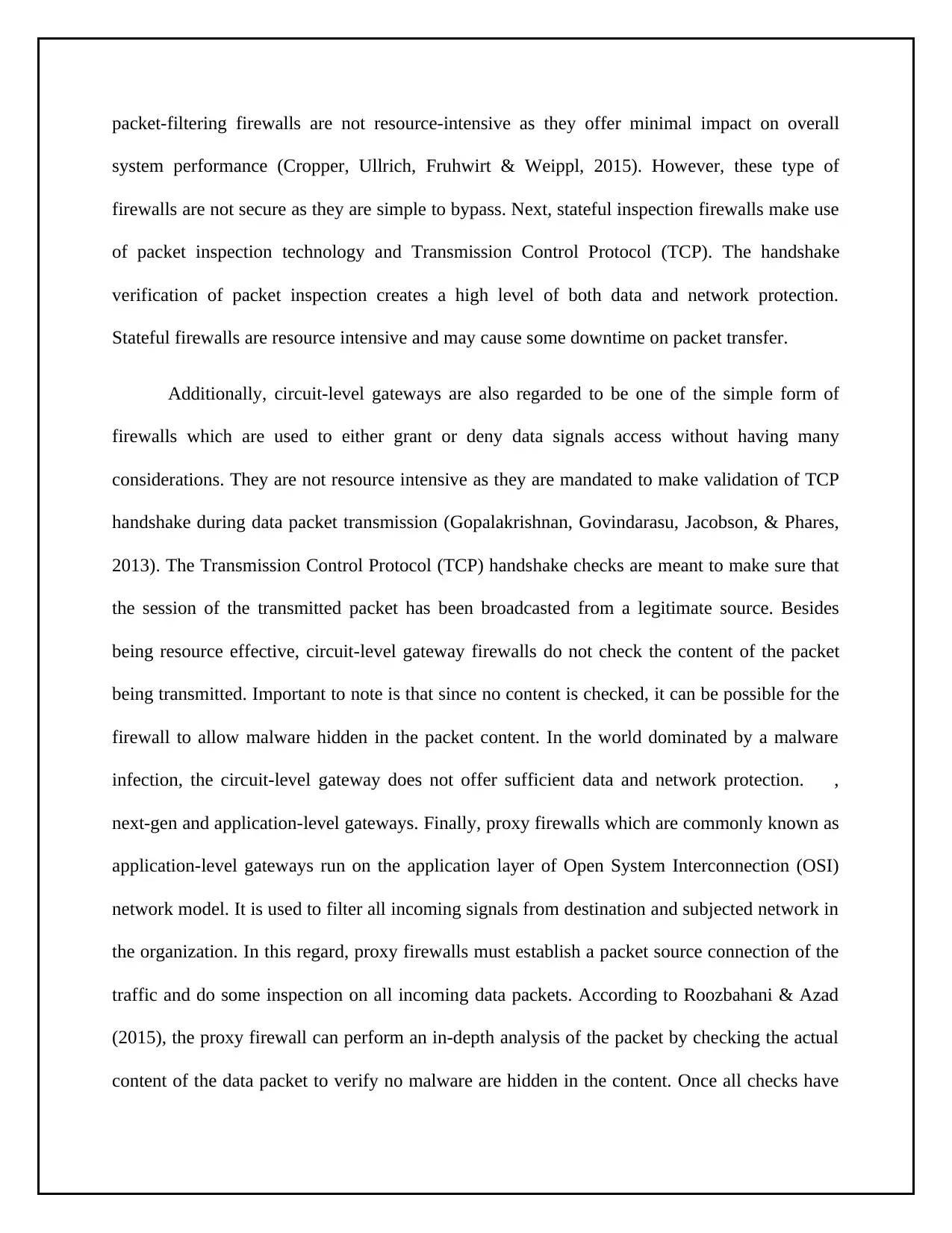
packet-filtering firewalls are not resource-intensive as they offer minimal impact on overall
system performance (Cropper, Ullrich, Fruhwirt & Weippl, 2015). However, these type of
firewalls are not secure as they are simple to bypass. Next, stateful inspection firewalls make use
of packet inspection technology and Transmission Control Protocol (TCP). The handshake
verification of packet inspection creates a high level of both data and network protection.
Stateful firewalls are resource intensive and may cause some downtime on packet transfer.
Additionally, circuit-level gateways are also regarded to be one of the simple form of
firewalls which are used to either grant or deny data signals access without having many
considerations. They are not resource intensive as they are mandated to make validation of TCP
handshake during data packet transmission (Gopalakrishnan, Govindarasu, Jacobson, & Phares,
2013). The Transmission Control Protocol (TCP) handshake checks are meant to make sure that
the session of the transmitted packet has been broadcasted from a legitimate source. Besides
being resource effective, circuit-level gateway firewalls do not check the content of the packet
being transmitted. Important to note is that since no content is checked, it can be possible for the
firewall to allow malware hidden in the packet content. In the world dominated by a malware
infection, the circuit-level gateway does not offer sufficient data and network protection. ,
next-gen and application-level gateways. Finally, proxy firewalls which are commonly known as
application-level gateways run on the application layer of Open System Interconnection (OSI)
network model. It is used to filter all incoming signals from destination and subjected network in
the organization. In this regard, proxy firewalls must establish a packet source connection of the
traffic and do some inspection on all incoming data packets. According to Roozbahani & Azad
(2015), the proxy firewall can perform an in-depth analysis of the packet by checking the actual
content of the data packet to verify no malware are hidden in the content. Once all checks have
system performance (Cropper, Ullrich, Fruhwirt & Weippl, 2015). However, these type of
firewalls are not secure as they are simple to bypass. Next, stateful inspection firewalls make use
of packet inspection technology and Transmission Control Protocol (TCP). The handshake
verification of packet inspection creates a high level of both data and network protection.
Stateful firewalls are resource intensive and may cause some downtime on packet transfer.
Additionally, circuit-level gateways are also regarded to be one of the simple form of
firewalls which are used to either grant or deny data signals access without having many
considerations. They are not resource intensive as they are mandated to make validation of TCP
handshake during data packet transmission (Gopalakrishnan, Govindarasu, Jacobson, & Phares,
2013). The Transmission Control Protocol (TCP) handshake checks are meant to make sure that
the session of the transmitted packet has been broadcasted from a legitimate source. Besides
being resource effective, circuit-level gateway firewalls do not check the content of the packet
being transmitted. Important to note is that since no content is checked, it can be possible for the
firewall to allow malware hidden in the packet content. In the world dominated by a malware
infection, the circuit-level gateway does not offer sufficient data and network protection. ,
next-gen and application-level gateways. Finally, proxy firewalls which are commonly known as
application-level gateways run on the application layer of Open System Interconnection (OSI)
network model. It is used to filter all incoming signals from destination and subjected network in
the organization. In this regard, proxy firewalls must establish a packet source connection of the
traffic and do some inspection on all incoming data packets. According to Roozbahani & Azad
(2015), the proxy firewall can perform an in-depth analysis of the packet by checking the actual
content of the data packet to verify no malware are hidden in the content. Once all checks have
Paraphrase This Document
Need a fresh take? Get an instant paraphrase of this document with our AI Paraphraser

been done, the proxy firewall sends it off and creates an additional layer that does separation
between networked client and individual device. The obstruction of the data packets is usually
done to create extra anonymity in the process of protecting the network. Due to increased
processes involved in the transmission of the data packet, proxy firewalls can be resource
intensive compared to other firewalls.
The best firewall architecture for an organization
During the survey, analysis to evaluate the firewall that best suites organizational needs,
IT administrator have to decide which firewall offer the best protection. The choice of the
firewall depends entirely on the goals of the organization and resources available to support
required operations. The main focus should be to determine capability to use only one firewall,
but none of the firewalls can offer comprehensive network and data protection (Kamara, Fahmy,
Schultz, Kerschbaum & Frantzen, 2013). To provide the quality protection to organizational
data, multiple layers of firewalls can be implemented at various network levels and the
perimeter. Implementation of more than one firewall in the network at different levels makes the
organizational network more resilient to vulnerable attacks. In this regard, it is essential to
highlight that the choice of the firewall by an organization would depend on network
capabilities, industry compliance requirements, and available resources to manage any chosen
firewall. For organizations that offer delicate services, proxy firewalls would be the best since it
provides additional operational features to secure organizational data. In cases where an
organization cannot depend on the implementation of a single firewall, several security measures
can be implemented at each network subnet (Arneja & Sachdev, 2015). By creating a centric
nature of the network and implementing a firewall at each layer, the organizational data would be
very secure because several firewalls would protect it.
between networked client and individual device. The obstruction of the data packets is usually
done to create extra anonymity in the process of protecting the network. Due to increased
processes involved in the transmission of the data packet, proxy firewalls can be resource
intensive compared to other firewalls.
The best firewall architecture for an organization
During the survey, analysis to evaluate the firewall that best suites organizational needs,
IT administrator have to decide which firewall offer the best protection. The choice of the
firewall depends entirely on the goals of the organization and resources available to support
required operations. The main focus should be to determine capability to use only one firewall,
but none of the firewalls can offer comprehensive network and data protection (Kamara, Fahmy,
Schultz, Kerschbaum & Frantzen, 2013). To provide the quality protection to organizational
data, multiple layers of firewalls can be implemented at various network levels and the
perimeter. Implementation of more than one firewall in the network at different levels makes the
organizational network more resilient to vulnerable attacks. In this regard, it is essential to
highlight that the choice of the firewall by an organization would depend on network
capabilities, industry compliance requirements, and available resources to manage any chosen
firewall. For organizations that offer delicate services, proxy firewalls would be the best since it
provides additional operational features to secure organizational data. In cases where an
organization cannot depend on the implementation of a single firewall, several security measures
can be implemented at each network subnet (Arneja & Sachdev, 2015). By creating a centric
nature of the network and implementing a firewall at each layer, the organizational data would be
very secure because several firewalls would protect it.
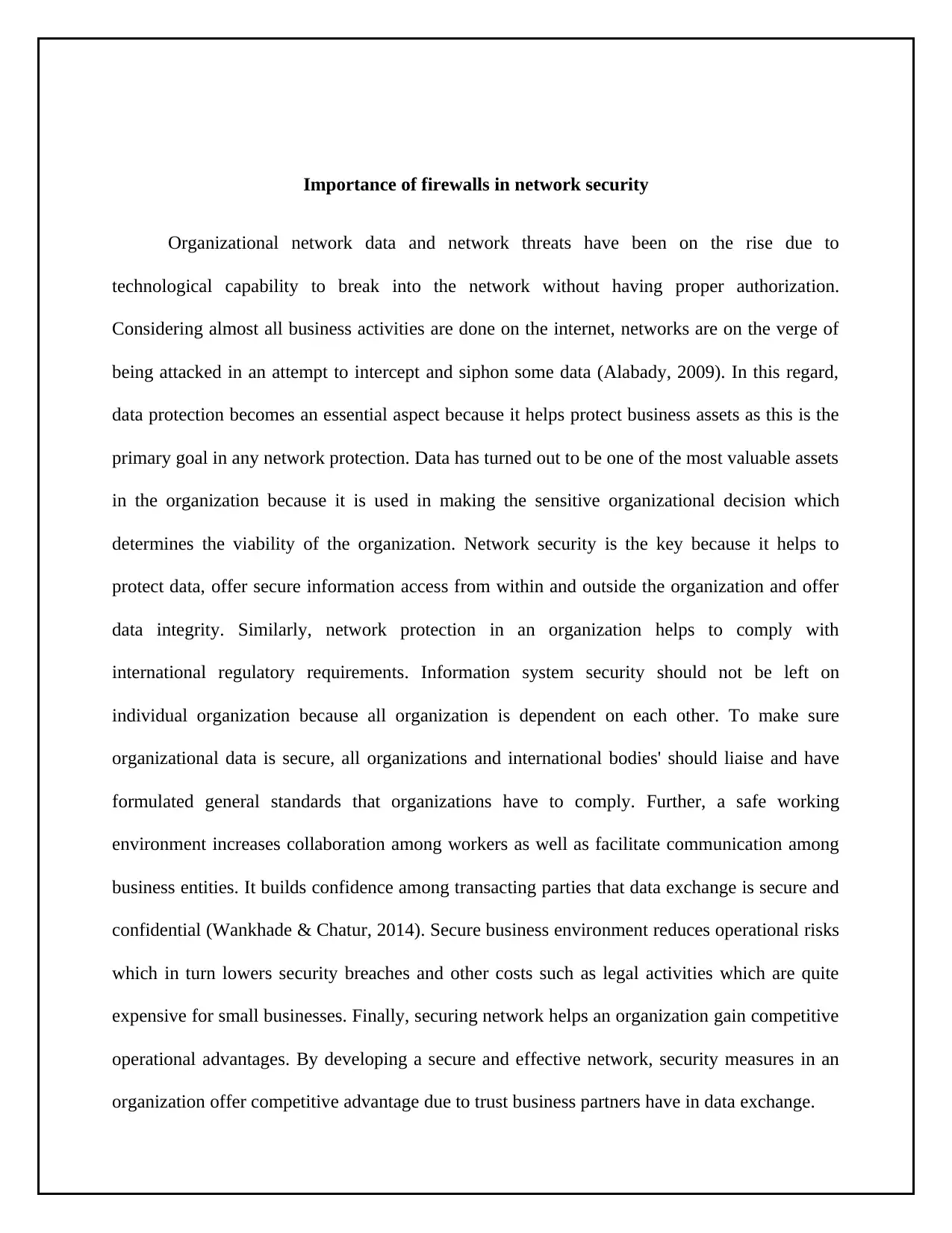
Importance of firewalls in network security
Organizational network data and network threats have been on the rise due to
technological capability to break into the network without having proper authorization.
Considering almost all business activities are done on the internet, networks are on the verge of
being attacked in an attempt to intercept and siphon some data (Alabady, 2009). In this regard,
data protection becomes an essential aspect because it helps protect business assets as this is the
primary goal in any network protection. Data has turned out to be one of the most valuable assets
in the organization because it is used in making the sensitive organizational decision which
determines the viability of the organization. Network security is the key because it helps to
protect data, offer secure information access from within and outside the organization and offer
data integrity. Similarly, network protection in an organization helps to comply with
international regulatory requirements. Information system security should not be left on
individual organization because all organization is dependent on each other. To make sure
organizational data is secure, all organizations and international bodies' should liaise and have
formulated general standards that organizations have to comply. Further, a safe working
environment increases collaboration among workers as well as facilitate communication among
business entities. It builds confidence among transacting parties that data exchange is secure and
confidential (Wankhade & Chatur, 2014). Secure business environment reduces operational risks
which in turn lowers security breaches and other costs such as legal activities which are quite
expensive for small businesses. Finally, securing network helps an organization gain competitive
operational advantages. By developing a secure and effective network, security measures in an
organization offer competitive advantage due to trust business partners have in data exchange.
Organizational network data and network threats have been on the rise due to
technological capability to break into the network without having proper authorization.
Considering almost all business activities are done on the internet, networks are on the verge of
being attacked in an attempt to intercept and siphon some data (Alabady, 2009). In this regard,
data protection becomes an essential aspect because it helps protect business assets as this is the
primary goal in any network protection. Data has turned out to be one of the most valuable assets
in the organization because it is used in making the sensitive organizational decision which
determines the viability of the organization. Network security is the key because it helps to
protect data, offer secure information access from within and outside the organization and offer
data integrity. Similarly, network protection in an organization helps to comply with
international regulatory requirements. Information system security should not be left on
individual organization because all organization is dependent on each other. To make sure
organizational data is secure, all organizations and international bodies' should liaise and have
formulated general standards that organizations have to comply. Further, a safe working
environment increases collaboration among workers as well as facilitate communication among
business entities. It builds confidence among transacting parties that data exchange is secure and
confidential (Wankhade & Chatur, 2014). Secure business environment reduces operational risks
which in turn lowers security breaches and other costs such as legal activities which are quite
expensive for small businesses. Finally, securing network helps an organization gain competitive
operational advantages. By developing a secure and effective network, security measures in an
organization offer competitive advantage due to trust business partners have in data exchange.
⊘ This is a preview!⊘
Do you want full access?
Subscribe today to unlock all pages.

Trusted by 1+ million students worldwide

Conclusion
Organizational data security and confidentiality remain to be a critical factor in the
modern world. IT infrastructure in any organization should be protected to make sure
confidential data is not released to unauthorized people. Network protection in organizations
forms the basis of data security because most of today's business process is done over the
internet. Once network security is guaranteed, it is presumed that the entire organizational data is
secure. In this regard, corporate network and data protection has to be implemented through the
use of firewalls. The firewall chosen by an organization can either be hardware or software
related. The main goal of using firewalls in securing the network is to analyze and filter all
incoming and outgoing data packet signals. Considering the nature of security threats posed by
hackers and malware infection, the firewall offers an opportunity to determine which signal is
genuine and authentic. The data packet should be analyzed to determine its source and the
destination. In cases where a firewall is unable to determine the authenticity of the data packet, it
has to be dropped. The nature of the firewall chosen should be able to satisfy organizational
requirements. The goal and the international security standards that an organization must meet
serve as the driver to the selection of firewall by an organization.
Organizational data security and confidentiality remain to be a critical factor in the
modern world. IT infrastructure in any organization should be protected to make sure
confidential data is not released to unauthorized people. Network protection in organizations
forms the basis of data security because most of today's business process is done over the
internet. Once network security is guaranteed, it is presumed that the entire organizational data is
secure. In this regard, corporate network and data protection has to be implemented through the
use of firewalls. The firewall chosen by an organization can either be hardware or software
related. The main goal of using firewalls in securing the network is to analyze and filter all
incoming and outgoing data packet signals. Considering the nature of security threats posed by
hackers and malware infection, the firewall offers an opportunity to determine which signal is
genuine and authentic. The data packet should be analyzed to determine its source and the
destination. In cases where a firewall is unable to determine the authenticity of the data packet, it
has to be dropped. The nature of the firewall chosen should be able to satisfy organizational
requirements. The goal and the international security standards that an organization must meet
serve as the driver to the selection of firewall by an organization.
Paraphrase This Document
Need a fresh take? Get an instant paraphrase of this document with our AI Paraphraser

References
Alabady, S. (2009). Design and Implementation of a Network Security Model for Cooperative
Network. Int. Arab J. e-Technol., 1(2), 26-36.
Amalina, N., Alsaqour, R., Uddin, M., Alsaqour, O., & Al-Hubaishi, M. (2013). Enhanced
network security system using firewalls. ARPN Journal of Engineering and Applied Sciences.
VOL. 8, NO. 12, 999-1003.
Arneja, P. S., & Sachdev, S. (2015). Detailed Analysis of Antivirus based Firewall and Concept
of Private Cloud Antivirus based Firewall. International Journal of Computer
Applications, 111(4), 16-22.
Cropper, J., Ullrich, J., Frühwirt, P., & Weippl, E. (2015). The role and security of firewalls in
iaas cloud computing. In 2015 10th International Conference on Availability, Reliability, and
Security, 1(1), pp. 70-79.
Dandamudi, S., & Eltaeib, T. (2015). Firewalls Implementation in Computer Networks and Their
Role in Network Security. J. Multidiscip. Eng. Sci. Technol, 2(3), 408-411.
Gopalakrishnan, K., Govindarasu, M., Jacobson, D. W., & Phares, B. M. (2013). Cybersecurity
for airports. International Journal for Traffic and Transport Engineering, 3(4), 365-376.
Hayajneh, T., Mohd, B. J., Itradat, A., & Quttoum, A. N. (2013). Performance and information
security evaluation with firewalls. International Journal of Security and Its Applications,
SERSC, 7(6), 355-372.
Kamara, S., Fahmy, S., Schultz, E., Kerschbaum, F., & Frantzen, M. (2013). Analysis of
vulnerabilities in internet firewalls. Computers & Security, 22(3), 214-232.
Roozbahani, F. S., & Azad, R. (2015). Security solutions against computer networks
threats. International Journal of Advanced Networking and Applications, 7(1), 2576.
Salaria, E. S., & Madaan, E. N. (2014). Firewall and Its Policies Management. International
Journal of Computer Science and Mobile Computing, 3(4), April- 2014, pg. 359-367
Tharaka, S. C., Silva, R. L. C., Sharmila, S., Silva, S. U. I., Liyanage, K. L. D. N., Amarasinghe,
A. A. T. K. K., & Dhammearatchi, D. (2016). High-Security Firewall: Prevent
Unauthorized Access Using Firewall Technologies. International Journal of Scientific
and Research Publications, 6(4), 504-508.
Vogel, J. D. (2015). Using Software Defined Networking To Solve Missed Firewall Architecture
In Legacy Networks. International Journal of Network Security & Its Applications
(IJNSA), 3(6), 59-79.
Alabady, S. (2009). Design and Implementation of a Network Security Model for Cooperative
Network. Int. Arab J. e-Technol., 1(2), 26-36.
Amalina, N., Alsaqour, R., Uddin, M., Alsaqour, O., & Al-Hubaishi, M. (2013). Enhanced
network security system using firewalls. ARPN Journal of Engineering and Applied Sciences.
VOL. 8, NO. 12, 999-1003.
Arneja, P. S., & Sachdev, S. (2015). Detailed Analysis of Antivirus based Firewall and Concept
of Private Cloud Antivirus based Firewall. International Journal of Computer
Applications, 111(4), 16-22.
Cropper, J., Ullrich, J., Frühwirt, P., & Weippl, E. (2015). The role and security of firewalls in
iaas cloud computing. In 2015 10th International Conference on Availability, Reliability, and
Security, 1(1), pp. 70-79.
Dandamudi, S., & Eltaeib, T. (2015). Firewalls Implementation in Computer Networks and Their
Role in Network Security. J. Multidiscip. Eng. Sci. Technol, 2(3), 408-411.
Gopalakrishnan, K., Govindarasu, M., Jacobson, D. W., & Phares, B. M. (2013). Cybersecurity
for airports. International Journal for Traffic and Transport Engineering, 3(4), 365-376.
Hayajneh, T., Mohd, B. J., Itradat, A., & Quttoum, A. N. (2013). Performance and information
security evaluation with firewalls. International Journal of Security and Its Applications,
SERSC, 7(6), 355-372.
Kamara, S., Fahmy, S., Schultz, E., Kerschbaum, F., & Frantzen, M. (2013). Analysis of
vulnerabilities in internet firewalls. Computers & Security, 22(3), 214-232.
Roozbahani, F. S., & Azad, R. (2015). Security solutions against computer networks
threats. International Journal of Advanced Networking and Applications, 7(1), 2576.
Salaria, E. S., & Madaan, E. N. (2014). Firewall and Its Policies Management. International
Journal of Computer Science and Mobile Computing, 3(4), April- 2014, pg. 359-367
Tharaka, S. C., Silva, R. L. C., Sharmila, S., Silva, S. U. I., Liyanage, K. L. D. N., Amarasinghe,
A. A. T. K. K., & Dhammearatchi, D. (2016). High-Security Firewall: Prevent
Unauthorized Access Using Firewall Technologies. International Journal of Scientific
and Research Publications, 6(4), 504-508.
Vogel, J. D. (2015). Using Software Defined Networking To Solve Missed Firewall Architecture
In Legacy Networks. International Journal of Network Security & Its Applications
(IJNSA), 3(6), 59-79.

Wankhade, A., & Chatur, P. N. (2014). Comparison of Firewall and Intrusion Detection
System. International Journal of Computer Science and Information Technologies, 5(1),
674-678.
System. International Journal of Computer Science and Information Technologies, 5(1),
674-678.
⊘ This is a preview!⊘
Do you want full access?
Subscribe today to unlock all pages.

Trusted by 1+ million students worldwide
1 out of 12
Related Documents
Your All-in-One AI-Powered Toolkit for Academic Success.
+13062052269
info@desklib.com
Available 24*7 on WhatsApp / Email
![[object Object]](/_next/static/media/star-bottom.7253800d.svg)
Unlock your academic potential
Copyright © 2020–2025 A2Z Services. All Rights Reserved. Developed and managed by ZUCOL.





